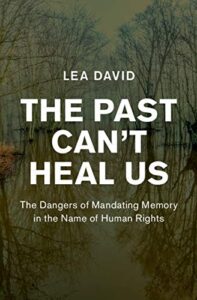 Upon reading Dr. Lea David’s recent essay “The Past Can’t Heal Us; the Double Edge Sword of the Human Rights Memorialization Agenda” as published in the Cambridge University Press blog, I was immediately taken by the originality of her central thesis – that mandating remembrance of historical injustices may not only serve not to remediate them but instead actually drive a deeper wedge into the society where the remediation is desired – and began to contemplate how at least a semblance of the the same challenge is beginning to be seen in areas of study closer to my own pursuits.
Upon reading Dr. Lea David’s recent essay “The Past Can’t Heal Us; the Double Edge Sword of the Human Rights Memorialization Agenda” as published in the Cambridge University Press blog, I was immediately taken by the originality of her central thesis – that mandating remembrance of historical injustices may not only serve not to remediate them but instead actually drive a deeper wedge into the society where the remediation is desired – and began to contemplate how at least a semblance of the the same challenge is beginning to be seen in areas of study closer to my own pursuits.
Admittedly, Prof. David’s book focuses squarely on human rights (a cause in which she very much believes), drawing heavily upon case studies of Palestine and Israel, and the Western Balkans, respectively, as well as the examination of the idea of moral remembrance. My own interests, of course, are more concerned with natural history – increasingly in the history and development of it.
Now this is where some are going to begin to throw turnips at me. Some of the developments toward the application of remembrance and reconciliation for historical injustices that I’ve been recently observing in the study of natural history at an academic level, as well as the study of the history of it itself and its related museology, appear to have similarities to the dynamics of moral remembrance described by Prof. David in her essay and explained in much greater detail in her recently published book The Past Can’t Heal Us: The Dangers of Mandating Memory in the Name of Human Rights.
I can’t say yet whether my interpretation of Prof. David’s work has any merit, as the copy of her book has only just arrived, but I’m very excited to pursue this enquiry in my reading of it. If my initial interpretations are correct, this may indeed be a work that will be important to a far more wide-ranging audience than it may have been originally intended.
